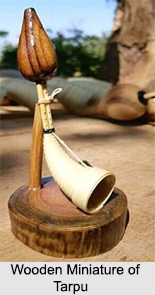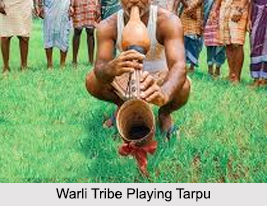 Tarpu is a wind instrument quite similar to the Pungi. It is also known as the Tarpo. It is found mainly in Gujarat and Maharashtra. Here, instead of a small gourd, a larger variety of Doodhia Bhopla (Marathi) is used as the air chamber fitted with two equal length bamboo reed pipes with a megaphone attached at the open end. It is used in group dance and folk ensembles in Gujarat and neighboring regions. This self-made wind instrument is typical for the music of the shepherds, as well as for the local Konknas who mainly grow grain.
Tarpu is a wind instrument quite similar to the Pungi. It is also known as the Tarpo. It is found mainly in Gujarat and Maharashtra. Here, instead of a small gourd, a larger variety of Doodhia Bhopla (Marathi) is used as the air chamber fitted with two equal length bamboo reed pipes with a megaphone attached at the open end. It is used in group dance and folk ensembles in Gujarat and neighboring regions. This self-made wind instrument is typical for the music of the shepherds, as well as for the local Konknas who mainly grow grain.
Structure of Tarpu
As in the Pungi there are two single reed pipes having three to five holes inserted into the gourd at the lower end. Further the tubes have a common funnel of wound Palmyra (tad) leaves, called Karna in Marathi Language, which acts as a sound radiator. Incidentally, it may be suggested that the name of the instrument is itself derivable from tad, the leaves of which are used in making the funnel. The blowing is done in two ways, from the end, where the top of the gourd is cut off and blown into and from the side, where a hole is made in the side of the air reservoir and blown into with a small tube often inserted in the aperture to act as a mouthpiece. The sound is produced by means of a tongue at the upper end of the tubes according to the principle of the pungi , known as the wind instrument of the snake charmers. A slightly inclined cut along the tube wall creates an idioglotte, a reed that is not visible from the outside and is pushed into a wax gourd. With the pungi, a bulbous wind capsule from a pumpkin or a coconut shell transfers the blown air to the play tube, here it is a slender bottle gourd with a long, curved neck. The air vent is not at the tip, but on the side. A short tube, inserted into the hole and firmly connected to the pumpkin, forms the mouthpiece.
Types of Tarpu
Tarpo has two kinds, the medium one is Ghogha and the larger one, sometimes of about 2 metres in length is the Khongada. In Gujarat, the smaller variety is often called the Dobru. In Gujarat, it is found among the tribals of Balsar and Surat district. The south Indian type, somewhat smaller counterpart to the north indian pungi with two play tubes is the magudi. The Mavchi, a subgroup of the Bhil in Maharashtra, play the approximately 60 centimeter long pawri which largely corresponds in shape to the tarpu. The bamboo tube of the pawri has three finger holes. In contrast to the tarpu , it is not blown on the side, but at the end of the pumpkin neck. In addition to wind instruments with reeds, the West Indian tribes play a number of bamboo flutes and natural trumpets such as animal horns and the metal trumpet tutari, which is curved in a semicircle. Seven pipes made of bamboo cane stick out of a bottle gourd during the rasem in the northeast Indian state of Tripura. This instrument, similar in appearance but functionally belonging to the oral organs, is blown through a pipe on the neck. Also within India limited to the northeast are single reed instruments of the pepa type, in which a buffalo horn is placed on the chime as a bell.
 Significance of Tarpu
Significance of Tarpu
The Warlis believe that Tarpu is a divine gift to them from “Naranâ€, the god of rains. It is a taboo to play Tarpu during summer and rainy season. Warli tarpu players also perform at temple festivals in honor of the goddess Mahalakshmi. In war dances, colorfully costumed men and women form a chain and move around a tarpu player standing in the middle. In general, the tarpu is used to accompany village dances. Professional musicians, including the dhodias, perform with her at weddings in Gujarat together with a percussive bronze gong (thali) and the double-headed barrel drum dholak or dholki.
In Maharashtra it is typical of the Warli people. The months of Bhadrapad and Asvin (about September to October) when the rice is ready for reaping Warli boys and girls gather to dance to the accompaniment of the Tarpu ensemble and competitions of Tarpu playing are held.




















